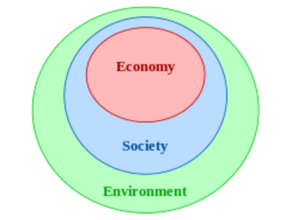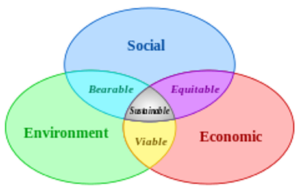The definition of Agroecosystem in Ecology derives directly from the Definition of Ecosystem. An Ecosystem is a functional unit of the environment that includes the interactions of all organisms (living or biotic components) and physical components (non-living or abiotic components) within a given area, for example a desert, a prairie, a forest, a lake, a spring, a cultivated area.
In the event that the area that includes the functional unit is a cultivated area, then that particular ecosystem will be defined as agroecosystem.
In ecology Sustainability describes how biological systems remain diverse, balanced and productive over time. In other words, sustainability is the capacity to endure: it is how biological systems remain diverse and productive indefinitely. Long-lived and healthy wetlands and forests are examples of sustainable biological systems. The organizing principle for sustainability is sustainable development, which includes the three interconnected pillars: environmental, economic and social.
Sustainability science is the study of sustainable development and environmental science. In 1987, the United Nations Brundtland Commission defined sustainability development as “meeting the needs of the present without compromising the ability of future generations to meet their own needs”. It contains within it two key concepts: the concept of needs, in particular the essential needs of the world’s poor, to which overriding priority should be given, and the idea of limitations imposed by the state of technology and social organization on the environment’s ability to meet present and future needs. A diagram can developed indicating the relationship between the “three pillars of sustainability”, in which both economy and society are constrained by environmental limits (Scott Cato, 2009). Venn diagram shows sustainable development as the confluence of three constituent parts (Adams, 2006) (Fig. 1).


Fig.1: Scott Cato diagram and Venn diagram
The last definition needed to complete the framework of the present document, is the Ecological Footprint (EF). EF is a measure of how much biologically productive land and water an individual, population or activity requires to produce all the resources it consumes and to absorb the carbon dioxide emissions it generates using prevailing technology and resource management practices (Global Footprint Network, 2011; Wackernagel, 1994)
